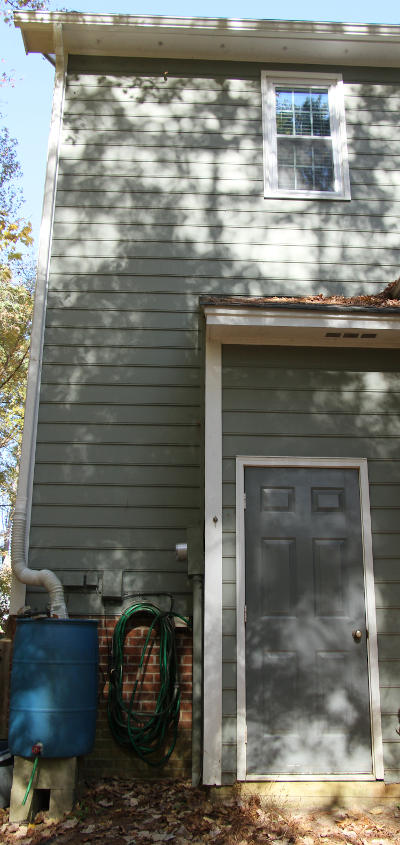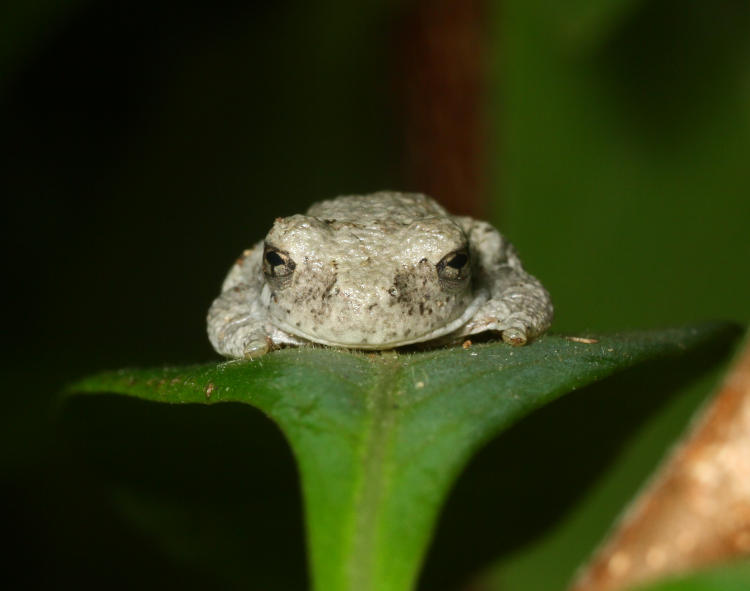While the temperatures have (like most of the east coast) dropped significantly for the past two weeks or more, I think this is a phase before real autumn and winter, and the past couple of days it’s actually gotten quite comfortable during the day. This prompted a little activity that surprised me, but I’m not knocking it.
The treefrogs remain largely sequestered, because they’re nocturnal and the overnight temperatures haven’t been too inviting, but the diurnal anoles have been taking advantage of the warm daytime sun and scampering around a bit. Yesterday, I glanced up at the back side of the house here at Walkabout Estates and noticed a Carolina anole (Anolis carolinensis) perched way up on the window frame, two-and-a-half stories up – and then another.

The larger one is, I suspect, the same one that I’ve been seeing on the corners of the house for a while, though not recently until now, while the smaller one – got me. The tail was slightly truncated, evidence of a narrow escape from something, and it was about 3/4 adult size. Male? Female? I don’t know, and the behavior didn’t answer this question.
I have to note that I was out checking the yard while The Girlfriend was in a Zoom meeting, so I only had the 80mm macro affixed and all of the other lenses were on the opposite side of the office from her, out of my reach during the meeting, so I could do nothing about improving my views here. Yes, say anything you want about lack of preparation – I was considering myself lucky to even find a decent subject to shoot at all. While these are cropped slightly, they’re framed to still give the more-distant perspective that I had from several meters below, not to mention that I had failed to get focus pinned with the manual Mamiya lens.
Meanwhile, the encounter progressed, often in slow motion.

 They were both aware of one another, and eventually the larger one began displaying its dewlap as it drew close. I would put this down to territoriality, but I’m not ruling out a mating display even though it’s much later in the season than I would suspect was ideal – I’m not sure about my knowledge of anole behavior, is what I’m saying. I was expecting an altercation, or at least some contact, but things were happening in minor increments with lots of pauses.
They were both aware of one another, and eventually the larger one began displaying its dewlap as it drew close. I would put this down to territoriality, but I’m not ruling out a mating display even though it’s much later in the season than I would suspect was ideal – I’m not sure about my knowledge of anole behavior, is what I’m saying. I was expecting an altercation, or at least some contact, but things were happening in minor increments with lots of pauses.
Which is why I wasn’t looking directly at them when something happened, but I spotted the falling object peripherally, and provide this image of the location (taken a day later when I could get my wide-angle lens) to illustrate. One of the anoles fell from the wall, bounced off of that little roof halfway down, and plopped into the leaves at the base of the rainbarrel, not quite at my feet (since I was standing back a bit for the view.) I crept forward slowly, and was rewarded by the anole scampering across the leaves to the base of the rainbarrel, quickly shinnying up it and pausing momentarily on the lip, since by this time I was leaning in close. It was certainly none the worse for wear after that drop, showing not even an inclination to move slower – this is likely a factor of their minimal body weight and ability to distribute impact, and given their territorial habits, I imagine it happens more than occasionally. Meanwhile the anole (clearly the smaller of the two,) was undeterred and started back up the downspout in the general direction of where it had come from, but I’d gotten a few closeups before that.

Ha! Now I was using the proper lens for the job!

The little one started up the downspout, while the larger one slipped over to the downspout itself and began moving to intercept. I’d been watching this for a few minutes now, and even shot some brief video clips as the smaller one was down within range, but again, things happened sporadically, and eventually I stopped watching when no exciting encounter appeared to be imminent. When checking back, I found the larger one near the top of the downspout, peering around carefully, and I can only assume the smaller one had dodged past somehow, especially when the larger one eventually slipped over the lip of the gutter on the roof edge, gave a couple of flashes of its dewlap, and disappeared a little at a time, being over a minute before the tail tip disappeared.
Today was just as warm, but I saw no sign of the antagonists/paramours, though I did find a little juvenile on the back fence.

This one was about twice the size of the juvie that I’d been following out front, of which there’s been no sign for weeks (but I’ll still take every opportunity to link to that photo.)
While doing some yardwork, I had dug up a small patch of sod that was mostly moss, and wanting to get a good patch established by the backyard pond, I took it back there to deposit it. As I brushed away the layer of ubiquitous pine needles, I unearthed a green treefrog (Hyla cinerea) that had dug itself in for the winter. I left it partially exposed while I fetched the camera, but on my return it was nowhere to be seen – until I crouched down and peeped underneath the layer of mossy sod that I’d just brought back.

That’s the sod on top, having formed a handy hollow, and the frog had lost no time in establishing a new hidey hole – this one considerably safer because it’s far less likely to get walked on there. I had adjusted the flash for the low angle, eliminating most of the natural shadows under the overhanging sod, making it seem like it’s much more exposed here than it really was.
That was not the only treefrog to be found, though.

A Copes grey treefrog (Hyla chrysoscelis) was tucked in on the branches of the paper bush (Edgeworthia papyrfera, I think,) obviously not enamored with the colder nights. It also looked like it had put on plenty of weight for the winter, if its rotund nature meant anything.
The next day it was still there, though having moved to a leaf that provided a better portrait angle.

There was no wind at all, so no, this wasn’t motion sickness no matter how much it looks like that. But it’s till a nice shot to close the post with.
How much more will be found before winter really sets in? Well, it’s impossible to say, especially when I found an active treefrog on christmas of last year. But the goal is to try and branch out away from these standard subjects a bit more. Still waiting on that funding for a winter trip, readers.




















































